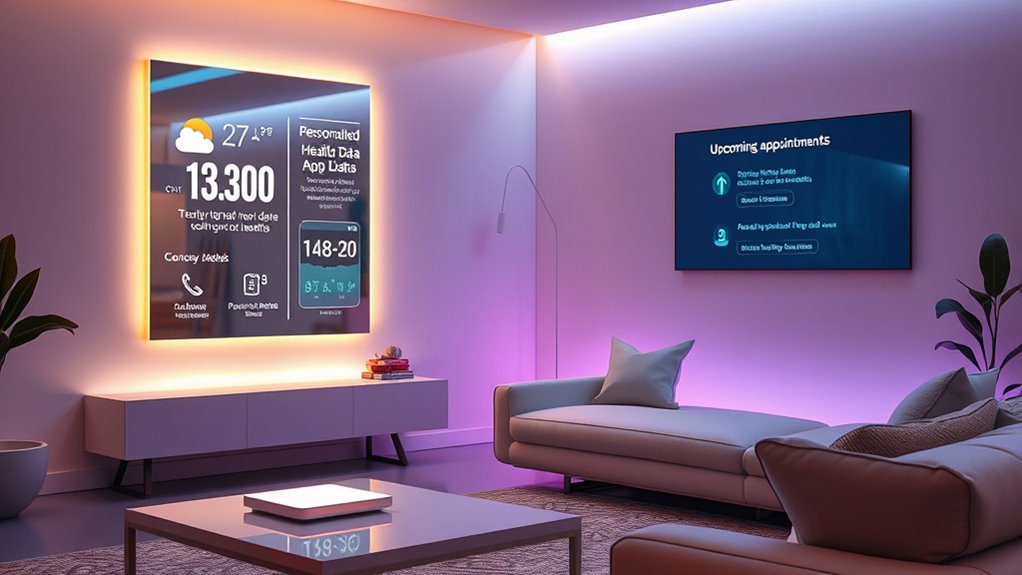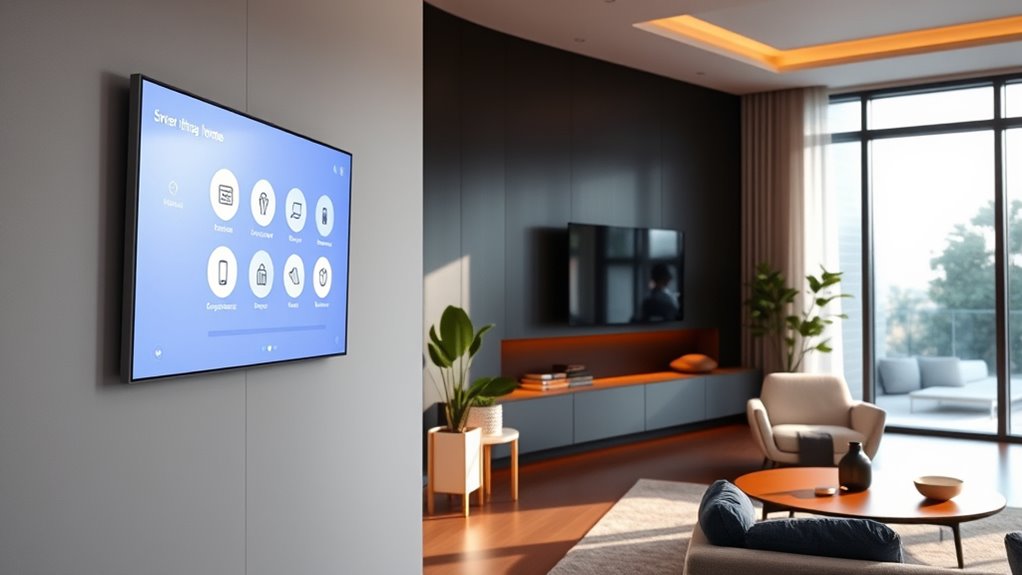Anticipatory design focuses on predicting your needs before you realize them, creating smooth and personalized experiences. It uses data, emotional insights, and advanced technology like AI to understand your preferences and behaviors. By responding proactively, systems can automate tasks and adapt seamlessly to your current state. Ethical considerations and privacy remain important, ensuring trust. To discover how these innovative approaches are shaping everyday interactions, more insights await as you explore further.
Key Takeaways
- Anticipatory design predicts user needs using data, machine learning, and emotional analytics to create seamless, personalized experiences.
- It leverages real-time sensor data and behavioral insights to proactively address user preferences before requests are made.
- Emotional intelligence enables interfaces to respond intuitively, fostering trust and deeper engagement through personalized cues.
- Ethical considerations ensure privacy and user control are prioritized while delivering proactive, anticipatory interactions.
- Future trends focus on empathetic, intuitive systems that empower users with more control and seamless, natural experiences.
The Foundations of Anticipatory Design

Anticipatory design is built on the idea that technology should predict and address your needs before you even realize them. At its core, it relies on emotional intelligence, enabling systems to understand and respond to your feelings and preferences. This approach fosters a more personalized experience, making interactions feel intuitive and natural. Cultural sensitivity plays a crucial role, ensuring the technology respects your background and social context, which helps avoid misunderstandings or offenses. By blending emotional intelligence with cultural awareness, anticipatory design creates solutions that are empathetic and relevant. Incorporating color accuracy into device calibration can further enhance the authenticity of visual experiences. The goal is to make your interactions seamless, proactive, and respectful of your individuality. This foundation sets the stage for a future where technology anticipates your needs with precision and care, enhancing your overall experience.
How Data Shapes Predictive Experiences

Your interactions generate valuable data that helps create personalized experiences. By analyzing this data, designers can anticipate your needs and deliver relevant content before you even ask. This approach transforms user engagement into a seamless, intuitive process. Additionally, leveraging predictive analytics enables platforms to adapt in real-time, further enhancing user satisfaction and loyalty.
Data-Driven Personalization Strategies
Data-driven personalization strategies harness the power of analytics and machine learning to tailor experiences to individual users. You leverage predictive analytics to analyze past behaviors and preferences, enabling more accurate forecasts of future needs. User segmentation divides your audience into specific groups based on shared characteristics, ensuring content and recommendations resonate deeply. By combining these approaches, you create dynamic experiences that adapt in real-time, providing relevant suggestions before users even realize they want them. This targeted approach increases engagement, boosts satisfaction, and fosters loyalty. Instead of generic interactions, your system anticipates individual desires, making every touchpoint more meaningful. With data shaping your personalization strategies, you deliver seamless, intuitive experiences that feel almost instinctive to your users. Additionally, leveraging AI discoveries can further refine these strategies by enabling more sophisticated predictive capabilities.
Anticipating User Needs
When you harness data effectively, predicting user needs becomes an intuitive part of your design process. By analyzing behavioral patterns and feedback, you can develop a keen sense of emotional intelligence, understanding what users feel and anticipate their reactions. This insight allows you to craft experiences that resonate on a deeper level, fostering sensory engagement that captures attention even before users realize what they want. Essential oils can serve as a metaphor for how subtle cues and personalized touches in your design evoke specific emotional responses. Predictive experiences aren’t just about algorithms; they involve reading subtle cues and adapting interfaces to meet unspoken needs. When your design aligns with users’ emotional states and sensory preferences, you create a seamless, personalized journey. This proactive approach transforms user interactions from reactive to anticipatory, making your experience feel intuitive, thoughtful, and genuinely responsive.
Key Technologies Driving Anticipation

Advancements in artificial intelligence and machine learning stand at the forefront of the technologies enabling anticipation. Sensor integration plays a essential role, collecting real-time data on your environment, behaviors, and physiological responses. This information helps systems understand your context more deeply. Emotional analytics further enhance this understanding by analyzing your facial expressions, voice tone, and biometric signals to gauge your mood and emotional state. Together, these technologies allow systems to detect subtle cues and predict your needs before you’re consciously aware of them. You might be surprised how seamlessly your devices can adapt, offering relevant suggestions or automating tasks based on your current state. These key innovations form the backbone of anticipatory experiences, making interactions more intuitive and personalized. Additionally, ongoing research into AI vulnerabilities and bias highlights the importance of developing robust safety measures to ensure these systems remain trustworthy and secure.
Designing for Personalization and Proactivity

You can create seamless experiences by tailoring user journeys to individual preferences. Anticipating needs effectively means understanding behavior patterns and acting proactively. Leveraging behavioral data helps you deliver personalized, timely interactions that keep users engaged. Incorporating user feedback into your design process ensures your solutions remain aligned with evolving needs and expectations.
Tailoring User Journeys
Personalization and proactivity are at the core of tailoring user journeys, enabling designs to anticipate and meet individual needs seamlessly. To do this effectively, you must leverage emotional intelligence, understanding users’ feelings and motivations to craft experiences that resonate deeply. Recognizing cultural nuances is equally essential, as it ensures your approach respects diverse values and behaviors. By integrating these insights, you create intuitive pathways that adapt to each user’s context, preferences, and expectations. This approach is similar to selecting the right planter types for various plants, ensuring optimal growth and engagement. This not only enhances engagement but also fosters trust and loyalty. Tailoring user journeys isn’t about generic customization; it’s about crafting a nuanced, empathetic experience that feels personalized and proactive at every touchpoint. When you align your design with emotional and cultural understanding, you deliver experiences users don’t just appreciate—they rely on.
Anticipating Needs Effectively
Anticipating user needs requires designing systems that proactively address expectations before they are explicitly expressed. To do this effectively, you leverage behavioral insights, understanding patterns and cues that reveal user intentions. Emotional intelligence plays a pivotal role, helping you interpret subtle signals and respond empathetically. By combining these elements, you craft personalized experiences that feel intuitive and supportive, rather than intrusive. For instance, recognizing when a user hesitates or revisits certain features allows you to preempt their needs seamlessly. This approach builds trust and satisfaction, as users sense you understand them without needing to ask. Ultimately, anticipating needs with behavioral insights and emotional intelligence transforms reactive interactions into proactive, meaningful connections.
Leveraging Behavioral Data
By analyzing behavioral data, you gain deeper insights into user habits and preferences, enabling you to craft experiences that are both personalized and proactive. This approach allows you to anticipate needs before users express them, increasing emotional engagement. However, balancing personalization with data privacy is essential; users must trust that their information is secure. Transparent data practices reassure users while enabling you to tailor content, recommendations, and interactions effectively. Leveraging behavioral data helps you create seamless, intuitive experiences that feel natural and relevant. When done ethically, this fosters stronger connections, making users feel understood and valued. Ultimately, harnessing behavioral data empowers you to design experiences that not only meet but exceed user expectations, driving loyalty and satisfaction.
Ethical Considerations and User Privacy

How can designers guarantee that anticipatory systems respect user privacy and adhere to ethical standards? First, you must address privacy concerns by implementing transparent data collection practices. Clearly inform users about what data is gathered and how it’s used. Incorporate ethical frameworks into your design process, ensuring decisions prioritize user rights and well-being. Regularly evaluate your system’s impact, adjusting to mitigate potential harm or misuse. Respect for user autonomy involves giving options to opt-out or control data sharing. By aligning design choices with established ethical standards, you create trust and safeguard user privacy. Additionally, understanding the power consumption of devices helps ensure responsible use and sustainability. Ultimately, thoughtful consideration of privacy concerns and adherence to ethical principles ensure anticipatory systems serve users responsibly without compromising their rights.
Real-World Examples of Anticipatory Interfaces

Many popular digital platforms now incorporate anticipatory interfaces that predict user needs and streamline interactions. For example, streaming services like Netflix use emotional intelligence to recommend shows based on your viewing history and mood. Smart home systems leverage sensory interfaces to adjust lighting and temperature automatically, creating a comfortable environment without your input. Virtual assistants, such as Siri or Alexa, anticipate questions by understanding context and preferences, making interactions more natural. These examples showcase how anticipatory design enhances user experience by proactively addressing needs before you ask. Additionally, understanding dog breed traits can help tailor these anticipatory interfaces to better serve user preferences in pet care and related industries. By integrating emotional intelligence and sensory interfaces, developers create more intuitive, seamless interactions that feel personalized and effortless—shaping a future where technology anticipates your needs almost intuitively.
Future Trends and Opportunities in Anticipatory Design

As technology continues to advance, the future of anticipatory design holds exciting opportunities to create even more personalized and seamless user experiences. You’ll see designs that leverage emotional intelligence, allowing systems to interpret your feelings and adapt accordingly. This means interfaces will respond not just to your actions but to your emotional states, fostering deeper engagement. Additionally, anticipatory design will empower you more by giving you control over how much guidance you receive, promoting user empowerment. Future trends include smarter AI that predicts your needs before you realize them and interfaces that feel more intuitive. These innovations will enhance your sense of agency, making digital interactions feel natural and unobtrusive. For example, integrating store hours awareness can help systems better understand when users are likely seeking specific services or products. Ultimately, anticipatory design will shift toward creating empathetic, empowering experiences tailored precisely to your evolving preferences.
Frequently Asked Questions
How Does Anticipatory Design Impact User Autonomy and Decision-Making?
You might wonder how anticipatory design affects your autonomy and decision-making. It can enhance user empowerment by anticipating your needs, making interactions smoother and more personalized. However, ethical considerations come into play, as it risks overstepping boundaries or manipulating choices. While it offers convenience, you should stay aware of how such designs influence your control, ensuring your decisions remain genuine and uninfluenced by unseen algorithms.
What Are the Limitations of Current Predictive Technologies in Anticipatory Design?
Imagine predictive tech as a weather vane, always pointing where it thinks you’ll go. But it’s limited by data gaps and algorithmic biases, like clouds obscuring the forecast. These flaws can mislead your choices or reinforce stereotypes, making the experience less reliable. You might feel caught in a storm of inaccuracies, unable to fully trust the technology, as it struggles to adapt to the nuanced, dynamic nature of your true needs.
How Can Designers Balance Anticipation With User Control and Customization?
To balance anticipation with user control and customization, you should focus on achieving a personalization balance that respects user preferences while offering helpful suggestions. Empower your users by giving them options to modify or turn off features, ensuring they feel in control of their experience. Incorporate feedback mechanisms so users can shape the system’s behavior, fostering trust and satisfaction while still leveraging predictive capabilities to enhance their journey.
What Are Potential Risks of Over-Reliance on Predictive Algorithms?
You should consider that over-reliance on predictive algorithms can lead to risks like algorithm bias, which may reinforce stereotypes or unfair treatment. Additionally, privacy concerns arise when these algorithms collect and analyze personal data without clear consent. This reliance might diminish user control and trust, making experiences feel intrusive or manipulated. Staying aware of these risks helps you design responsibly and ensure user needs and rights are prioritized.
How Does Anticipatory Design Influence Long-Term User Behavior and Engagement?
Imagine a gentle nudge guiding your habits over time, subtly shaping your interactions. Anticipatory design influences your long-term behavior by fostering emotional engagement and making tasks feel effortless. As you develop new habits, you might find yourself more connected and satisfied with the experience. This seamless engagement encourages ongoing use, reinforcing positive behaviors and deepening your relationship with the product without you even realizing it.
Conclusion
As you navigate the evolving landscape of anticipatory design, imagine it as a lighthouse guiding users through uncharted waters, illuminating needs before they’re even spoken. By harnessing data and technology, you create experiences that feel like a trusted friend, always one step ahead. Embrace ethical boundaries like sturdy anchors, ensuring your innovations steer safely. In this future, your designs become the silent, invisible hand steering users toward seamless, intuitive journeys they never knew they needed.









